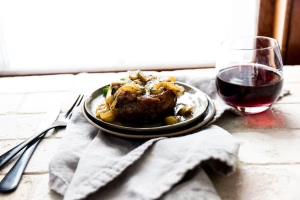You don’t have to be a food or wine expert to pair the two together. There are a few simple rules to follow that will not only allow you to choose a wine that pairs perfectly with your meal, but one that elevates both.

Complementary
The first thing to know is that, when pairing wines and food, is that there are two routes to go down. Firstly, whether you are drinking a Riesling or a cask red wine, you can pair them complementary, which is typically the route most people choose.
In simple terms, complementary pairings involve matching the flavors of the wine with the flavors in the food to accentuate both. For example, a sweet white wine pairs well with salty food, as the salt tones down the sweetness and brings out the fruity flavors in the wine.
Congruent
Congruent pairings are also simple, as they are wines and food that share similar profiles, such as sweet wines paired with desserts, or a red wine with red meat. This is another typical pairing, and is also one that many people prefer.
Flavor Profiles & Wine
Now that you know a few general rules, here are some tips to help you pair wines with certain flavor profiles.
Salt
Salt is incredibly common in foods, and the saltiness of many can sometimes overpower the flavor of some wines. Because of this, opting for a sweet or acidic wine can help cut through and balance the saltiness of food, preserving the taste of both it and the wine.
Sweet
With sweet foods, there is a bit of a balancing act required. If the wine isn’t sweet enough, it will be overpowered by the food, but if it is too acidic, it will taste even more bitter. Instead, try a dessert wine that is sweeter than the dessert you are eating to keep the flavors balanced.
Acid
Considering acid is a flavor common in both food and wine, it is fairly easy to create both complementary and congruent pairings. For starters, the wine should be at least equally as acidic as the food, so that it doesn’t taste bland; hence, the wine should be more acidic than the food to keep the balance.

Fat
Considering fat and fatty flavors aren’t found in wine, you need to rely on wine tannins. The bitterness created by tannins can soften the fattiness in foods, while the slight acidity can cut through it. This is why red wine is such a popular choice when eating red meat.
Bitter
When serving bitter food, it is always best to avoid pairing them with bitter wines, as the unpleasant bitter flavor will only be enhanced. Acidic or slightly sweeter wines always go best with bitter foods, as the acid or sweet flavor will tone down the bitterness.
Spicy
Spicy foods often comprise a variety of flavors, and this makes both complementary and congruent pairings perfect. One thing to remember is that spicy foods can increase the bitterness and acidity of wines, and decrease the sweetness. Riesling is the typical choice as it can stand up to the spiciness.
Tips to Remember
Finally, here are a few tips to remember that you can use in a pinch no matter what wine you have on hand at the time.
Red Wine & Red Meat
As mentioned before, red wine of some description will almost always be the best choice to pair with red meat. The flavors balance each other perfectly; both are improved when paired together, and a red wine that goes well with a steak will go well with a roast.
White Wine & Light Meat
On the other end of the spectrum, white wine is the perfect accompaniment to light, delicate meats, like chicken and most fish dishes. This is because most white wines don’t tend to have one or two overwhelming flavors, much like many light meats.
You can think of it like squeezing lemon over a piece of fish; neither flavor is stronger than the other, yet together, they create something delicious.
Similar Adjectives
Another simple trick to pair wine and food is to think about the adjectives you would use to describe each. For example, you would describe a berry tart as fruity, sweet, slightly acidic, etc. A white wine can be described in a similar fashion, therefore the two would make a good match.
This applies to a variety of other alcohol as well, which is why a smoky bourbon or whisky is used in either the cooking process, or paired with barbecue foods such as ribs, brisket, or pulled pork.

Pairing With Sauces
Finally, it can sometimes be tricky or not overly clear which wine to pair with a food, most notably, in salads or foods with heavy sauces. Because of this, instead of focusing on the food, pair the wine with the flavors of the sauce or dressing.
This makes it much easier as you can simply work out if a sauce is rich and meaty, or if a dressing is light and acidic. For salads, in particular, just focus on the dressing, as the ingredients typically lack much standout flavor.



